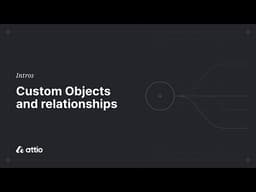Understanding objects
The fundamental building blocks of Attio.
What are objects?
In Attio, there are two types of objects: standard objects and custom objects.
Standard objects
An object is a data structure that allows you to organize and present data in a certain way. It’s the equivalent of a table within a spreadsheet. You could also think of it as a blueprint for you how store your data.

For a video walkthrough, see Standard Objects in Attio Academy.
A standard object is an object that is natively supported by Attio. There are 5 standard objects:
| Object | Use Case | Enabled by default? |
|---|---|---|
| People | Stores information about any person who interacts with your business. | Yes |
| Companies | Stores information about any company that interacts with your business. | Yes |
| Deals | Tracks potential sales between your company and another organization or individual. | No |
| Workspaces | Tracks information about accounts using your product, including connected users and companies. | No |
| Users | Tracks information about the users of your product, including the person and workspace records they are connected to. | No |
Each standard object comes with a pre-defined set of attributes, which you can find in Workspace settings > Objects.
Attio has two standard objects enabled by default: Peopleand Companies, and three other standard objects that you can activate: Deals, Workspaces and Users. We’ll dive into the reasons for why you might use these in a later section.
You can activate other standard objects (as well as custom objects) by going to Workspace settings > Data > Objects.
Custom objects
A custom object is exactly what it sounds like: a data structure that is customized uniquely for your business.
If Attio’s standard objects don’t align close enough with your business model, then you can easily create a custom object that aligns exactly to your needs.

For a video walkthrough, see Custom Objects in Attio Academy.
How to create a custom object
To create a custom object, go to Workspace settings > Data > Objects and click Create custom object.
You’ll need to name the entity you are tracking. For example, if you’re a B2B SaaS company, it might be subscriptions. In this case, your plural noun will be Subscriptions and your singular noun Subscription.
You’ll also want to choose an identifier that will also serve as a slug. We recommend choosing something as close as possible to your noun (in this case, /subscriptions).
When should I use a custom object?
You should use custom objects if your data and workflow structures don’t work neatly with standard objects. Custom objects allows you to mold your CRM exactly to your business and data model.
For example, if you’re a B2B marketplace, you may want to create custom objects for Buyers, Sellers, and Transactions, in addition to the Attio Standard Objects of People, Deals, and Companies.
Example: B2B marketplace
| Type | Object | Description |
|---|---|---|
| Custom | Buyers | Those purchasing your products/services in your marketplace. |
| Custom | Sellers | Those selling products/services in your marketplace. |
| Custom | Transactions | Data store for every transaction that occurs. |
| Standard | People | Contacts who you deal with on the non-marketplace side of your business. |
| Standard | Companies | Companies who you deal with on the non-marketplace side of your business. |
| Standard | Deals | A potential sale that your business wants to track between your company and another organization or individual . |
Object relationship types
One of the most powerful aspects of objects is that you can specify their relationship types. This allows you to define how objects are connected and interact with each other. In Attio, there are three types of object relationships:
one to manymany to manyone to one
For example, in the case of our B2B marketplace, you’d want your Buyers object to have a one to one relationship with Companies, and a one to many relationship with Transactions.
This setup lets you see at a glance who a buyer is working with and all the deals they're involved in.
If we were to sketch out our complete data model for our B2B marketplace, it would look like this:
| Object | Relationship Type | Object |
|---|---|---|
| Buyers | one to one | Companies |
| Buyers | one to many | Transactions |
| Sellers | one to one | Companies |
| Sellers | one to many | Transactions |
| Companies | one to many | People |
| Companies | one to many | Deals |
In our B2B marketplace data model:
Each buyer is connected to only one company (
Buyershas a one to one relationship withCompanies). This keeps data organized by ensuring every buyer is accurately linked to their respective company.However, a buyer can have many transactions (therefore
Buyerhas aone to manyrelationship withTransactions). This allows tracking all the deals a buyer has been involved in over time.Similarly, each seller belongs to a single company, but can have multiple transactions (
Sellershas aone to onerelationship withCompaniesand aone to manyrelationship withTransactions).A company can have several people linked to it, and be involved in numerous deals (
Companieshave aone to manyrelationship with bothPeopleandDeals). This enables monitoring all the individuals and deals associated with a particular company.
Defining the relationships between your objects creates a clear structure for your data and leads to better growth, management, processes, and insights into how different parts of your business work together.
Learn more
For an even deeper dive about objects, reference the Objects articles in our Reference section.
Up next
Learn in more depth about attributes.